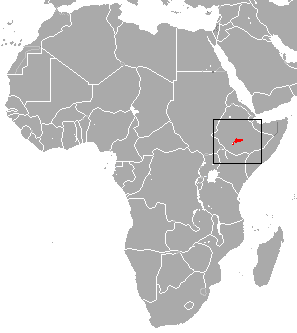Chlorocebus
Chlorocebus is a genus of medium-sized primates known as the green monkeys or vervet monkeys, which are native to sub-Saharan Africa. This genus contains several species, which are often characterized by their greenish-olive or silvery-gray body color, with contrasting black faces and white underparts. They are highly adaptable and can be found in a variety of African ecosystems, including savannas, woodlands, and mountains.
Description[edit | edit source]
Members of the genus Chlorocebus are generally social animals, living in large groups that can consist of dozens to over a hundred individuals. These groups are multi-male, multi-female societies, with a complex social structure and hierarchy. They are known for their high level of social interaction, including grooming and vocal communications, which play a significant role in their social bonding and hierarchy.
The diet of Chlorocebus species is omnivorous, consisting of a wide variety of plants, fruits, seeds, insects, and occasionally small vertebrates. Their adaptability to different types of habitats and broad diet is a key factor in their widespread distribution across Africa.
Species[edit | edit source]
The genus Chlorocebus includes several species, such as:
- Chlorocebus aethiops (African green monkey or vervet monkey)
- Chlorocebus pygerythrus (South African vervet)
- Chlorocebus sabaeus (Green monkey)
- Chlorocebus tantalus (Tantalus monkey)
- Chlorocebus djamdjamensis (Bale Mountains vervet)
- Chlorocebus cynosuros (Malawi vervet)
Habitat and Distribution[edit | edit source]
Chlorocebus species are found throughout sub-Saharan Africa, from Senegal and Ethiopia in the east to South Africa in the south. Their habitats range from dry savanna to woodland and mountainous areas, demonstrating their adaptability to various environmental conditions. They are often found near water sources and can also adapt to agricultural and urban areas, where they sometimes come into conflict with humans due to crop raiding and other behaviors.
Behavior and Ecology[edit | edit source]
Vervet monkeys are diurnal and spend most of their time foraging for food. They have a complex social structure, with both male and female hierarchies. Males typically leave their natal groups upon reaching maturity, while females remain with their kin. Communication among Chlorocebus species involves a variety of vocalizations, facial expressions, and body postures.
Predation is a significant risk for Chlorocebus, with their main predators including leopards, eagles, and pythons. They have developed various anti-predator strategies, including alarm calls that vary depending on the type of threat.
Conservation Status[edit | edit source]
The conservation status of Chlorocebus species varies. While some species are abundant and have adapted well to human-altered environments, others face threats from habitat destruction, hunting, and the pet trade. Conservation efforts are focused on habitat preservation and mitigating human-wildlife conflicts.
In Research[edit | edit source]
Chlorocebus species, particularly the African green monkey and vervet monkey, have been important in biomedical research. They have been used in studies on social behavior, neuroscience, and infectious diseases, among other areas. Their physiological similarities to humans make them valuable models for medical research, though this use raises ethical considerations.
Search WikiMD
Ad.Tired of being Overweight? Try W8MD's physician weight loss program.
Semaglutide (Ozempic / Wegovy and Tirzepatide (Mounjaro / Zepbound) available.
Advertise on WikiMD
|
WikiMD's Wellness Encyclopedia |
| Let Food Be Thy Medicine Medicine Thy Food - Hippocrates |
Translate this page: - East Asian
中文,
日本,
한국어,
South Asian
हिन्दी,
தமிழ்,
తెలుగు,
Urdu,
ಕನ್ನಡ,
Southeast Asian
Indonesian,
Vietnamese,
Thai,
မြန်မာဘာသာ,
বাংলা
European
español,
Deutsch,
français,
Greek,
português do Brasil,
polski,
română,
русский,
Nederlands,
norsk,
svenska,
suomi,
Italian
Middle Eastern & African
عربى,
Turkish,
Persian,
Hebrew,
Afrikaans,
isiZulu,
Kiswahili,
Other
Bulgarian,
Hungarian,
Czech,
Swedish,
മലയാളം,
मराठी,
ਪੰਜਾਬੀ,
ગુજરાતી,
Portuguese,
Ukrainian
Medical Disclaimer: WikiMD is not a substitute for professional medical advice. The information on WikiMD is provided as an information resource only, may be incorrect, outdated or misleading, and is not to be used or relied on for any diagnostic or treatment purposes. Please consult your health care provider before making any healthcare decisions or for guidance about a specific medical condition. WikiMD expressly disclaims responsibility, and shall have no liability, for any damages, loss, injury, or liability whatsoever suffered as a result of your reliance on the information contained in this site. By visiting this site you agree to the foregoing terms and conditions, which may from time to time be changed or supplemented by WikiMD. If you do not agree to the foregoing terms and conditions, you should not enter or use this site. See full disclaimer.
Credits:Most images are courtesy of Wikimedia commons, and templates Wikipedia, licensed under CC BY SA or similar.
Contributors: Prab R. Tumpati, MD





